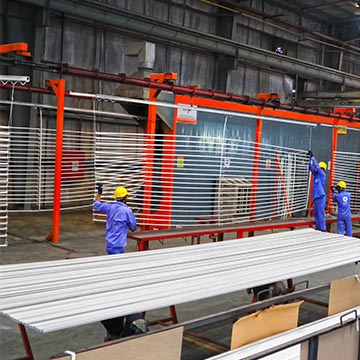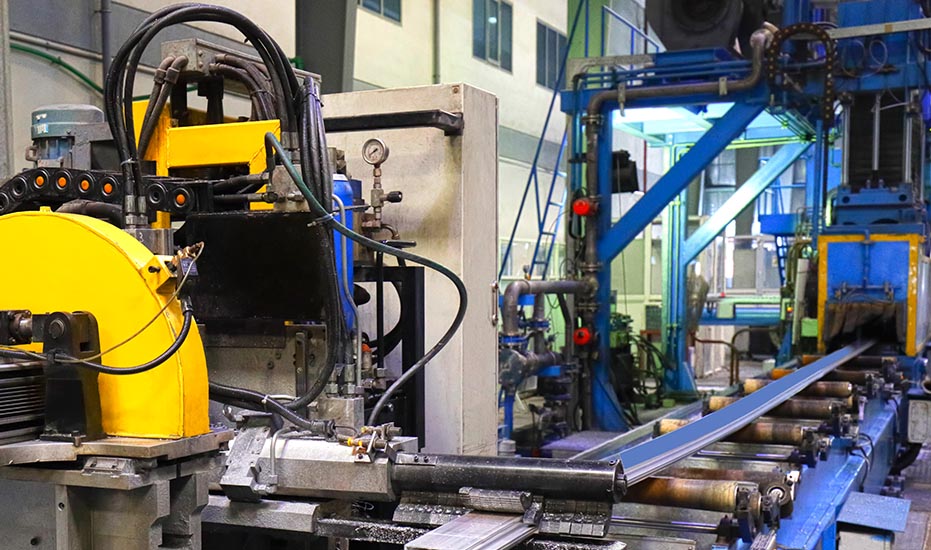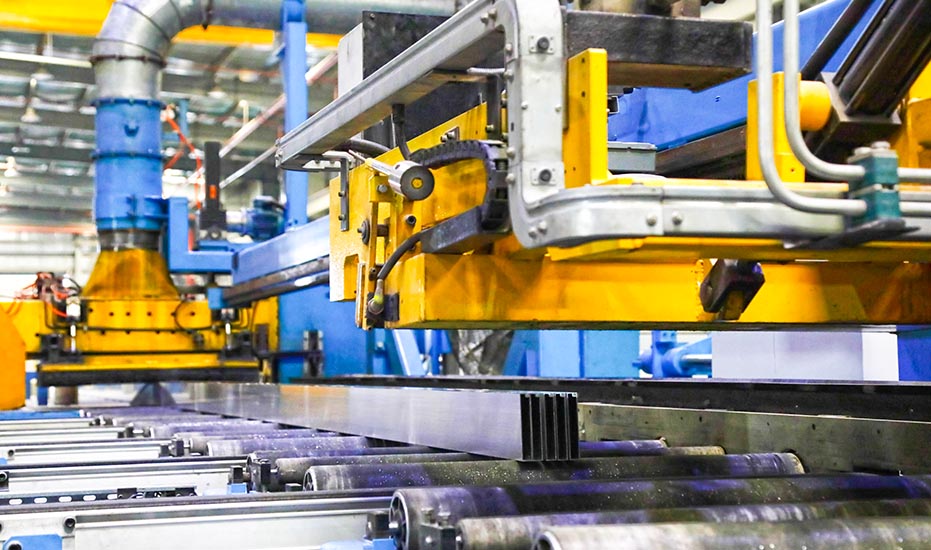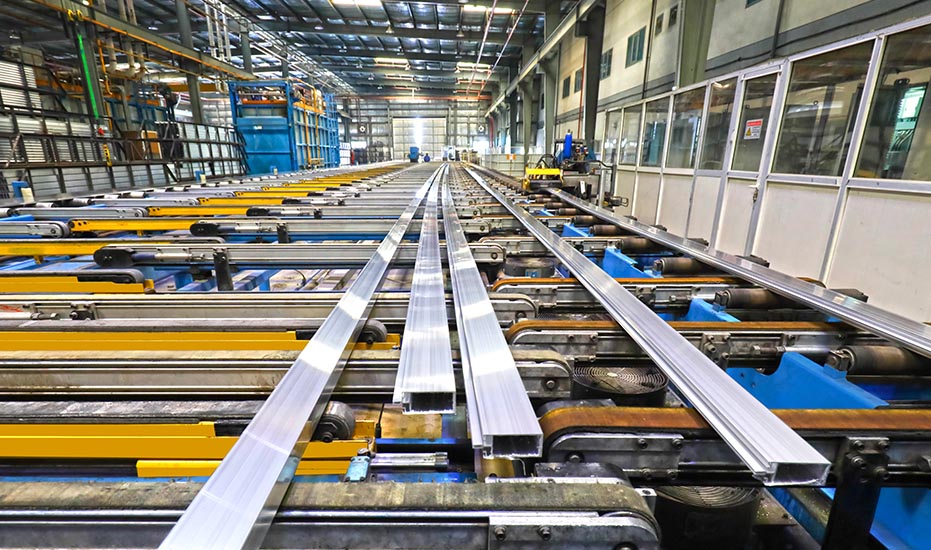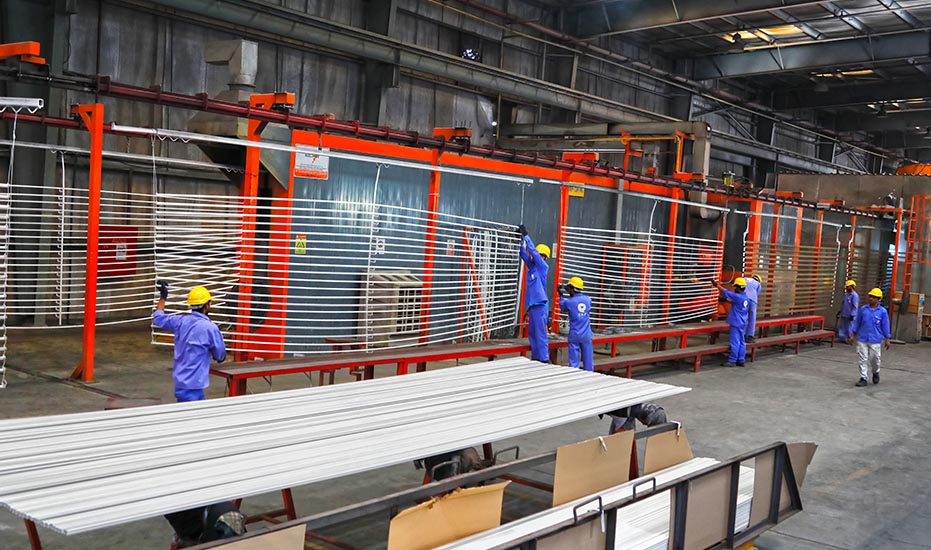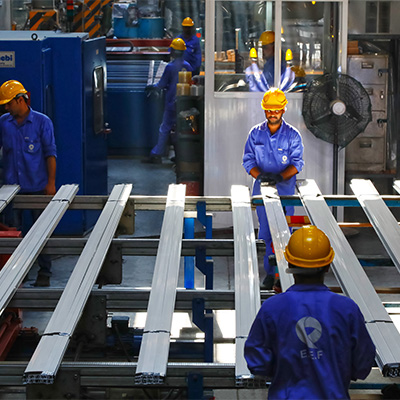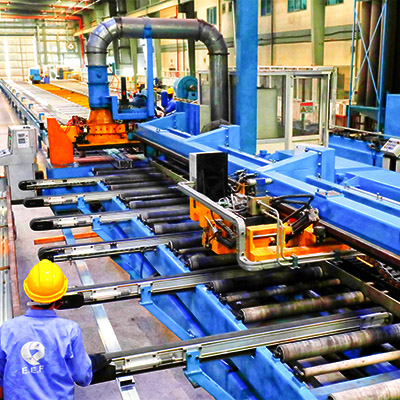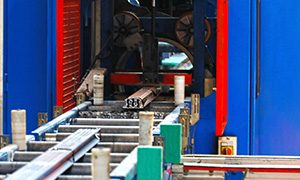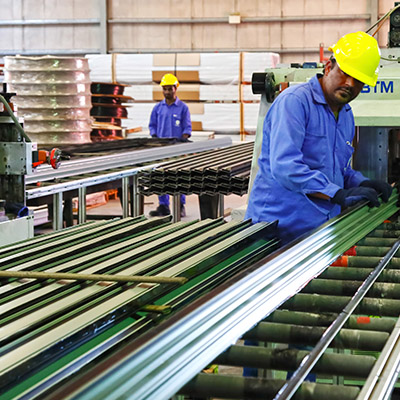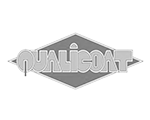
Aluminum
Aluminum is today the most important industrially used metal after steel with the applications in almost all fields and all areas of everyday life due to its light-weight, high strength and recyclability.
Aluminum has been described as “the material of opportunity” and is the fastest growing metal today due to its unique combination of properties – high strength and low weight, good electrical and thermal conductivity, excellent formability, good resistance corrosion and attractive surface finish – which means it can be used practically in all design contexts and product applications.
Aluminum is extracted from its oxide “alumina” by the Hall-Heroult process in smelters. Alumina is extracted from bauxite by the Bayer process in Alumina refinery.
Aluminum can be recycled and used time and time again, whilst using only a fraction of the energy required for its primary production.
Advantages of Aluminium Extrusion : Aluminium extrusion is easier than welding. Construction companies prefer this for several reasons. It is economical as well as helps to fabricate parts with an invariable cross section. Aluminium is a good heat protector and the metal can be easily bonded with adhesive. And above all, aluminum extrusion machines are cost-effective to fit.
Advantages of Aluminium Extruded Products : The benefits of aluminum products are diverse.
- Light weight: The weight of aluminum is one-third of iron, steel, copper or brass. It is easier to carry and handle the metal.
- Strength: Aluminium products and aluminum extrusion profiles can be made as strong as needed.
- Strength and weight ratio: The united property of strength and lightness in aluminum extruded products makes it a key component of several industry based applications.
- Corrosion resistant: The metal has a natural protective coating against environmental, chemical and physical corrosive materials.
- Heat transmission: Aluminium is a better conductor of heat on a cost and weight basis.
- Electric transmission: Aluminium is a better conductor over copper per unit weight. It is commonly used for power consumption.
- Wide approval: Aluminium extruded products are largely used in the food packaging and chemical industry.
- Easy to manufacture: The metal, by using the conventional methods, can be given any shape.
- Easy for assembly design: Aluminium extruded products are easy for assembly design.
- Ability to join: Methods like welding, soldering, brazing are used to join extrusions.
- Superior quality: Aluminium extruded products guarantee trustworthiness and uniformity in quality.
- Cost-effectiveness: The tools used in extrusion process are comparatively cheaper in comparison to other production methods.
- Variety in finishing: Aluminium extruded products is known for their finishing varieties.
Aluminium alloys and tempers
Emirates Extrusion produces most of customer requirements in its facilities using alloys 6061 and 6063 with T4, T5 and T6 tempers.
6061 is a precipitation hardeningg aluminum alloy, containing magnesium and silicon as its major alloying elements. It has good mechanical properties and exhibits good weldability. It is one of the most common alloys of aluminum for general purpose use.
6063 is an aluminum alloy, with magnesium and silicon as the alloying elements. It has generally good mechanical properties and is heat treatable and weldable. 6063 is mostly used in extruded shapes for architecture, particularly window frames, door frames, and roofs. It is typically produced with very smooth surfaces fit for anodizing.
- T4 : Solution heat treated and naturally aged to substantially stable condition
- T5 : Cooled from an elevated temperature and then artificially age hardened
- T6 : Solution heat treated and artificially age hardened
Chemical Composition of Alloys 6063 and 6061, Tempers T5 & T6
| Designation | Alloy 6063 | Alloy 6061 |
| Magnesium (%Mg) | 0.45 – 0.90 | 0.80 – 1.20 |
| Silicon (%Si) | 0.20 – 0.60 | 0.40 – 0.80 |
| Chromium (%Cr) | 0.10 | 0.04 – 0.35 |
| Zinc (%Zn) | 0.10 | 0.25 |
| Iron (%Fe) | 0.35 | 0.70 |
| Cupper (%Cu) | 0.10 | 0.15 – 0.40 |
| Manganese (%Mn) | 0.10 | 0.15 |
| Titanium (%Ti) | 0.10 | 0.15 |
| Others | 0.05 | 0.05 |
| Aluminium | Remainder | Remainder |
Mechanical properties of Alloys 6063 and 6061, Tempers T5 & T6
| Alloy 6063 | Alloy 6061 | ||||
|---|---|---|---|---|---|
| T5 | T6 | T7 | T8 | ||
| Ultimate tensile strength | MPa | 150 | 185 | 190 | 280 |
| 0.2% proof stress | Mpa | 110 | 160 | 115 | 240 |
| Hardness brinell | BHN | 55 | 75 | 60 | 90 |
| Ultimate shear strength | Mpa | 155 | 205 | ||
| Elongation on 50 mm | % | 8 | 8 | ||
| Density | g/cm 3 | 2.7 | 2.7 | ||
| Melting range | Degree Celsius | 600 – 650 | 580 – 650 | ||
| Coefficient on linear expansion | x 10 3 /°C | 23 | 24 | ||
| Modulus of elasticity | Gpa | 67,000 | 69,000 | ||
| Fatigue strength (50*10 6 ) cycle | Mpa | 75 | 95 | ||

Extrusion
Extrusion is defined as the process of shaping material, such as aluminum, by forcing it to flow through a shaped opening in a die. Extruded material emerges as an elongated piece with the same profile as the die opening.
In aluminum extrusion process, a billet is heated to an appropriate temperature and then pushed under high pressure by a hydraulic press through a shaped opening in a special steel die. The profile cross-section of which corresponds the opening of the die is then quenched, stretched, cut to required length and finally aged to achieve a desired hardness.
Extrusion profiles are available in various alloys and tempers so as to provide a wide range of mechanical and physical properties.Emirates extrusion operates two presses of 1,650 tons each with 7 inches billets. The rated capacity is 12,000 tons per year. Our extrusion presses are positioned to efficiently uphold the manufacturing process; allowing us to provide consistent lead-times in the industry and on-time delivery performance.Both presses are operated to strict standards ensuring superior extrusion with excellent surface quality. High tolerance aluminum extrusions are provided using commercial alloys, 6061 and 6063, subject to temper requirements and products specification. Emirates Extrusion also provides both custom and standard shapes based on customer’s requirements.

Powder coating
Powder coating is a type of coating that is applied as a free-flowing, dry powder. The main difference between a conventional liquid paint and powder coating is that the powder coating does not require a solvent to keep the binder and filler parts in a liquid suspension form.
It is an advanced method of applying a protective and decorative finish to a wide range of materials. The powder coating on the aluminum helps to enhance the ability of the metal to resist corrosion and damage from the elements.
In the powder coating process, aluminum profiles are cleaned and chromated, and then transferred to a spraying booth where an electrostatically charged polyester powder is sprayed on profiles under controlled parameters.After been sprayed, profiles are cured in a special oven to achieve a hard, uniform and well bonded powder coated film.
Our on-site powder coating facility offers finishing in a variety of RAL colors, on lengths up to 6.8 meters. Our powder coating plant is equipped with precision instruments especially designed to control the quality of profiles and to ensure that the specifications set by standards of QUALICOAT are met. Our powder coating products and processes comply with local and international standards such as QUALICOAT, BS EN and ISO.

Anodizing
Anodizing is an electro-chemical conversion process. The surface of the metal is converted to aluminum oxide as a result of reactions going on at the anode in an acidic solution.
After cleaning and etching, aluminum profiles are immersed in sulfuric acid solution under controlled parameters. An electric current flows through the solution to produce an aluminum oxide film, which is extremely hard, durable and corrosion resistant.
Aluminum profiles are then electro or dye colored to obtain aesthetic colors such as light, medium and dark bronze, silver, gold, etc.
Sealing is the final stage in anodizing process and it is done in hot water solution. The purpose of sealing process is to close porous aluminum oxide layer after the anodizing step in order to enhance the durability of the finishing.
Emirates Extrusion, with its capacity of 16,000 – 18,000 tons per year, produces all anodizing finishes such as natural silver, gold, light, medium and dark bronze, and black in matt or shiny finish. The anodizing process and products respond to the international quality standard requirements such as European EN, British BS, ISO and Qualanod.
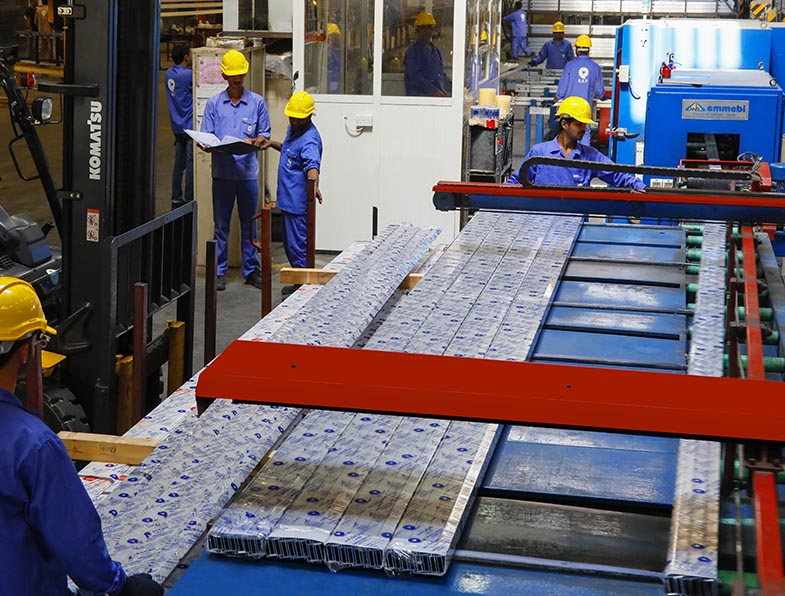
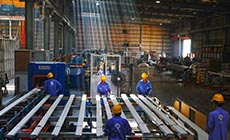
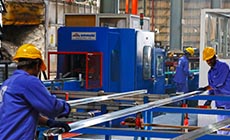
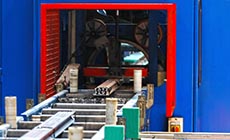

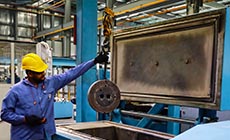
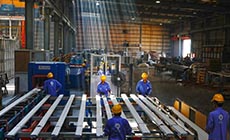

WOOD GRAIN EFFECT
WOOD GRAIN EFFECT – In its simplest aesthetic meaning, wood grain is the alternating regions of relatively darker and lighter wood resulting from the differing growth parameters occurring in different seasons, wood effect coating is now in demand in the fields of architectural industries, wood effect coating is a special powder coating process based on the latest technology in the surface finishing.The powder coating wood grain process is a sublimation process, using pressure and heat combined. The decorative patterns of faux wood grain are transferred into powder coated surfaces that have been completely cured.

Thermal Break System
In 2001, Emirates Extrusion integrates the concept of Thermal Break System in its in-house production. The design of the system has been carefully studied to fit with common accessories in the market, which can be easily machined using ordinary equipment in the workshop. A thermal break is an element of low thermal conductivity placed in an assembly to reduce or prevent the flow of thermal energy between conductive materials.
The thermal broken system consists of two independent profiles with similar or unlike shapes connected by “polyamide” strips in order to obtain one monolithic profile having low UV factor and low transmission sound.
This will minimize heat transfer between the interior and exterior of doors and windows, which will improve the energy saving better than traditional systems. Our in-house thermal broken profiles assembling process is done by four single operations: knurling, strip feeding, crimping and testing. The assembling process guarantees tensile, bending, twisting, and slipping strength of the monolithic thermal broken profile. Recently, new line was installed which has increased the capacity to 2,400 tons per year.
